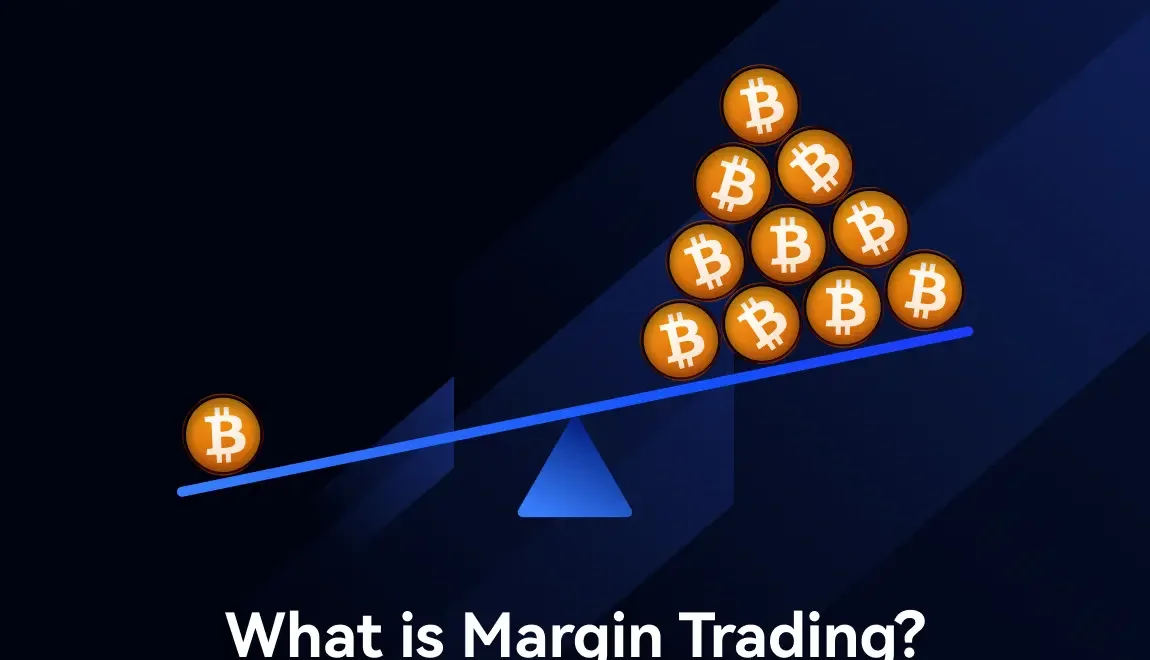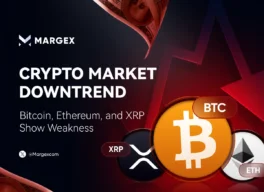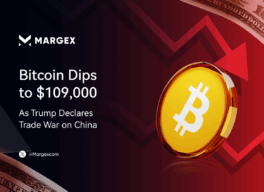
Margin trading is one level up on your trading account you put in a little of your cash and a little “loan” provided by the broker to take a larger trade. Simply explained, you place a deposit (margin) as a security and you borrow the remainder to either sell an asset or purchase one.
This is considered to be a leveraging of your position, that is, your profits (and losses) are increased. This is in contrast to ordinary spot trading where you just purchase an asset with your entire funds margin trading allows you to possess a bigger position with a small portion of the cash outlay. Just imagine it is a purchase on credit: you pay only a part of the price now and the remainder you pay with the money of the broker.
In a margin trade, you require a special margin account. In a margin account, the broker loans you the money to purchase more than you would be able to with your cash used solely. Using the above example of Bitcoin (BTC) trading at $100,000, you may only require $20,000 (20% margin) of your funds to execute a $100,000 position with 5x leverage, which is suitable for all investors if they understand the risks. The platform loans you the rest of $80,000.
You will pay back this margin loan in the future, and a little margin interest (similar to interest on a loan) on the money that you borrowed. In case the price of BTC increases, you get to keep the profit once the loan is repaid. However, on the downside, losses are exaggerated when you use margin, and it is even possible to end up owing more than you put in, which is why it is described as a high-risk, high-reward strategy.
How Margin Trading Works?
Margin means borrowing money to invest in financial markets, allowing traders to purchase securities on margin. To begin, investors must have a margin account and can open a margin account through brokers like Charles Schwab futures and forex. This type of trading magnifies the potential gains and losses.
When traders purchase on margin, they use a portion of their own funds and borrow the rest, incurring a margin interest rate on the loan. The margin loan balance can fluctuate based on the stock price and the components of margin trading include adhering to securities and exchange commission regulations.
Traders can also engage in options trading, allowing for various strategies. However, trading securities on margin comes with benefits and risks of margin; if the value of securities in your account drops, brokers may issue a margin call, requiring additional funds to maintain positions.
To manage risk, traders can set their own margin requirements, and it’s crucial to pay attention to the pay margin interest obligations. Understanding how margin works is essential for informed trading decisions.
| Leverage | Margin Requirement | You Provide | You Borrow |
|---|---|---|---|
| 2x | 50% | $5,000 | $5,000 |
| 5x | 20% | $2,000 | $8,000 |
| 10x | 10% | $1,000 | $9,000 |
| 100x | 1% | $100 | $9,900 |
Margin trading involves a few key steps. Let’s break it down in order, using easy terms related to the risks of margin trading:
| Step | Description |
|---|---|
| Open Position | You choose leverage, asset, trade size and provide collateral. |
| Maintain Margin | You must maintain a minimum equity (maintenance margin). |
| Margin Call | If your equity drops too low, you must deposit more or the position will be closed. |
| Exit Trade | You manually or automatically close the trade and settle profits or losses. |
1. Choose Your Leverage
First, select the amount of leverage you wish to use margin for. Leverage is just the multiplication of your money by how many times. So, 5x leverage would translate to 20 percent of the trade being your money and 80 percent borrowed, and 10x would be 10 percent of your money and 90% borrowed. Most platforms such as Margex allow you to set leverage of up to 100x but the higher the leverage the more you are risking.
The margin requirement is what percent of the trade you have to put up as collateral to meet a margin call. E.g., with 5x leverage the margin is 20%. The greater the leverage you select the smaller the margin requirement (and the larger your position). To take an example, a 20% margin requirement on a 10,000 trade implies that you must have 2000 upfront.
2. Open a Position
After selecting leverage, you then open a position (long or short). Within a margin account, you place an order as usual, however, the system will automatically work out the required amount of your funds (margin). In the trade interface on Margex, you will choose the collateral (e.g. USDT or any other asset) and write in the size of the trade.
There is even a convenient margin slider that can figure a percentage of your available balance to spend. You can also see “Margin Cost” on the interface – that is the amount of your money that will be held as collateral on this trade. By way of illustration, purchasing 1 BTC at 10,000 using 5x leverage implies that 2,000 USD is provided as a margin (the remaining 8,000 is the loan). Your trade opens once you place the order. Going long, you make money when the price goes up; going short you make money when the price goes down.
3. Maintain Your Margin
Once you have opened a position, you have to ensure that you have sufficient equity in your account. Each trade has a maintenance margin (a minimum balance) which you are required to maintain. A margin call will be received by you in case your losses increase and your remaining margin is too low.
Margin call is a request by the platform/broker to either deposit more money or to Close positions promptly to avoid the incurrence of margin interest debt.. The platform will automatically liquidate (close) your position to limit your losses in case you do not take action. To take an example, say you have placed a 2,000 USD margin on a 5x BTC trade and the market has moved against you to such an extent that your account equity has fallen to the maintenance margin level, then you will have to top up, or your position will be closed out at the market price. Practically, this is also why many traders place stop-loss orders automatically exits level selling the trade in case it reaches a specific level- to limit their losses and not to get pushed out of the trade by a margin call.
4. Exit the Position
The last step is to exit your trade (manually or using stop-loss/take-profit orders). At your close, the platform will pay out your profit or loss. In the case the trade profited, then your profit (less any fees/interest) is returned to your wallet. In case it made a loss, the loss is deducted from the margin you had put aside. As an illustration, a profitable trade on BTC may give you $1,000 of profit that you can either withdraw or re-invest in a subsequent trade.
On closing, your collateral in margin is returned (assuming any remains) and the loan is repaid (together with any margin interest). Even on Margex, you may close a position partly, e.g. 40 percent, and thus take some profit, leaving the remaining position open.
Spot Trading vs. Margin Trading: What’s the Difference?
When it comes to trading in the financial markets, two common methods are spot trading and margin trading. Understanding the differences between these two approaches is crucial for investors looking to optimize their trading strategies.
What is Spot Trading?
Spot trading refers to the purchase or sale of a financial instrument, such as stocks or cryptocurrencies, for immediate delivery and settlement. In spot trading, the transaction occurs at the current market price, known as the spot price. For example, if you buy Bitcoin at the current price of $20,000, the transaction is finalized immediately, and you own the Bitcoin outright.
What is Margin Trading?
Margin trading allows investors to borrow money from a broker to trade larger positions than they could with just their cash. This is done through a margin account, where investors can use leverage to amplify their potential profits. For instance, if you have a margin account and want to buy $10,000 worth of stock but only have $5,000 in cash, you can borrow the additional $5,000 from your broker, allowing you to trade on margin.
Consider the following examples to illustrate the differences:
- Spot Trading Example: You buy 1 Ethereum (ETH) for $1,500 using your brokerage account. You pay the full amount upfront, and the transaction is settled immediately. You own 1 ETH outright.
- Margin Trading Example: You want to purchase 2 ETH worth $3,000, but you only have $1,500 in your margin account. You take out a margin loan from your broker for the remaining $1,500. If the price of ETH increases to $2,000, your investment is now worth $4,000. After repaying the margin loan, your profit is magnified, demonstrating how margin can enhance potential gains.
Spot trading involves buying or selling assets for immediate delivery, while margin trading allows traders to borrow funds to increase their position size. Understanding the basics of buying on margin is crucial, as margin refers to the funds borrowed from a broker to amplify potential profits.
Before trading on margin, it’s essential to know the initial margin requirement and broker’s maintenance margin requirements. Margin can magnify both gains and losses, making it vital to implement sound trading strategies. Traders can take out a margin loan with specific margin loan rates that may vary.
Margin Trading on the Margex Platform
Margex is a crypto derivatives exchange that allows you to buy on margin with simple margin trading options. It provides up to 100x margin and isolation margin as well as gross margin. In isolated margin mode, you have locked up a set amount of funds into a single trade (so you can only lose that margin). When you are in cross-margin mode, your entire available balance of the collateral currency may be used to fund your trades – profits of winning positions and the remaining balance may be used to keep other trades alive.
The Open Positions section The open trades section is at the bottom of the terminal, and here you will find all of your trades that are currently using margin. Here it is easy to view the size of each position, entry price, current profit/loss, and leverage.
Margex possesses several unusual features in addition to trading. The first one is the Multi-Chart mode. You may open up to a few charts next to each other and observe various assets or time frames simultaneously. Another is the MP Shield, an anti-manipulation system that keeps prices fair.
Margex aggregates liquidity from about 12 different providers and uses MP Shield to filter out spoofing or wash trades. This means the order books on Margex are very deep with tight spreads and minimal slippage generally giving you better prices than a smaller brokerage account might.
Real-Life Example: 5x Leverage Bitcoin Trade
| Scenario | BTC Price | Position Value | Loan | Your Margin | Profit / Loss | Result |
|---|---|---|---|---|---|---|
| Opening the Trade | $10,000 | $10,000 | $8,000 | $2,000 | $0 | Position opened |
| BTC Rises | $11,000 | $11,000 | $8,000 | $2,000 | +$1,000 | $3,000 total — 50% gain |
| BTC Falls | $8,000 | $8,000 | $8,000 | $2,000 | −$2,000 | Margin wiped — 100% loss |
To make it concrete, let’s run through a simple example of how margin trading allows you to buy more than you could with just your own capital. Suppose Bitcoin (BTC) is trading at $10,000 and you want to go long (buy) with 5x leverage. If you open 1 BTC position at $10,000, a 5x leverage means you only need $2,000 of your own money (20% margin) and borrow $8,000.
Opening the Trade: You use $2,000 as margin and Margex loans you $8,000. You then own an effective $10,000 position in BTC.
If BTC Rises: Say BTC goes up to $11,000. Your position is now worth $11,000 you gained $1,000. You close the trade and repay the $8,000 loan. You end up with $3,000 ($11,000 minus $8,000). Since you started with $2,000, your profit is $1,000, which is a 50% gain on your initial margin.
If BTC Falls: Suppose instead BTC drops to $8,000. Your position is worth $8,000, a $2,000 loss. Closing means you get $8,000, pay back the $8,000 loan, and are left with $0. Your entire $2,000 margin is wiped out (a 100% loss of your deposit). In a real scenario, the position would likely be liquidated before hitting $0 equity if that would breach the minimum margin requirement.
This example shows how leverage magnifies results. Using 5x leverage can double or wipe out your deposit. A similar example from Margex’s docs: trading 1 BTC at $10,000 with 10x leverage (0.1 BTC margin = $1,000) and selling at $11,000 yields a $1,000 profit. With 5x leverage our profit is smaller in percentage, but the principle is the same you profit or lose on the full $10,000 movement, not just your $2,000 stake. Always remember that the margin loan of $8,000 must be repaid, plus any small funding interest accrued.
Safety Tips for Margin Trading
Margin trading is powerful, but it comes with risks. Here are some beginner tips to trade safely, especially when using a margin trading account:
Use Stop-Loss Orders: Stop-loss orders should always be taken into consideration. A stop-loss automatically sells you out when the price reaches a level of your choice, regardless of the level of your losses. According to Pepperstone, stop-losses are beneficial in that they limit the losses in margin trading. Otherwise, nice market movement can evaporate your margin without you even being able to respond.
Know Your Margin Levels: Monitor maintenance margin and available funds. The interface at Margex displays cross-margin levels, although either way, be aware of the maintenance margin requirement, and do not allow equity to become too low. When you notice that you are nearing a margin call then you can either deposit money or cut down on position sizes. The brokers, like OANDA, recommend that you should never lever your account 100 percent and leave some margin.
Diversify and Withdraw Profits: Never invest all your money into a single trade. When you are in several positions in the same currency one price movement may result in a margin call on each. Diversify to spread risk. Also, when you have some profits, think of taking out some or transferring it to a safe wallet. It could be tempting to reinvest all your gains on margin but this is risky.
FAQ
How does margin trading work?
Margin trading provides you with an opportunity to borrow money to enlarge your position size. You put up a small margin, borrow the balance, and trade a larger size. Your profits and losses are computed on the total position and not just your money.
What is a $500 margin on a $10,000 position?
That is 20x leverage. Your initial margin is $500 and you have acquired a margin loan of $9,500, which is subject to the margin rate set by the exchange. That is a risky structure and a 5 percent price change can lead to liquidation.
Is trading on margin a good idea?
It depends. Margin trading can be profitable, but it’s risky due to the potential for incurring margin loan interest. It’s best for traders who:
Understand volatility
Use stop-losses to protect your margin trading account.
Avoid emotional decisions
If you’re just starting, trade small, use low leverage, and learn with demo accounts if possible.
What is an example of a margin trade?
Suppose you enter a margin position where you purchase 5x leverage of Ethereum to the tune of 10,000 US dollars with 2,000 US dollars of your capital. Should ETH increase by 10 percent, your position will be worth 11,000 dollars. That is 1,000 dollars in profit, a fifty percent increase on your 2000 dollars, which showcases the potential rewards of buying on margin, prior to trading. However, a 20% fall in ETH will wipe your $2,000 and liquidate your position.






